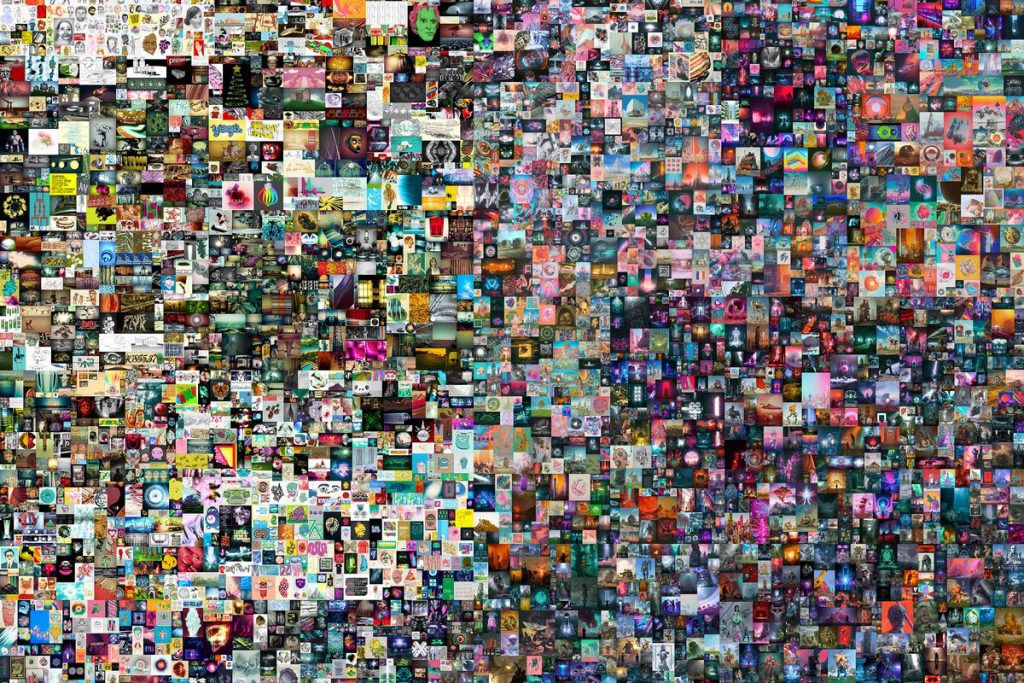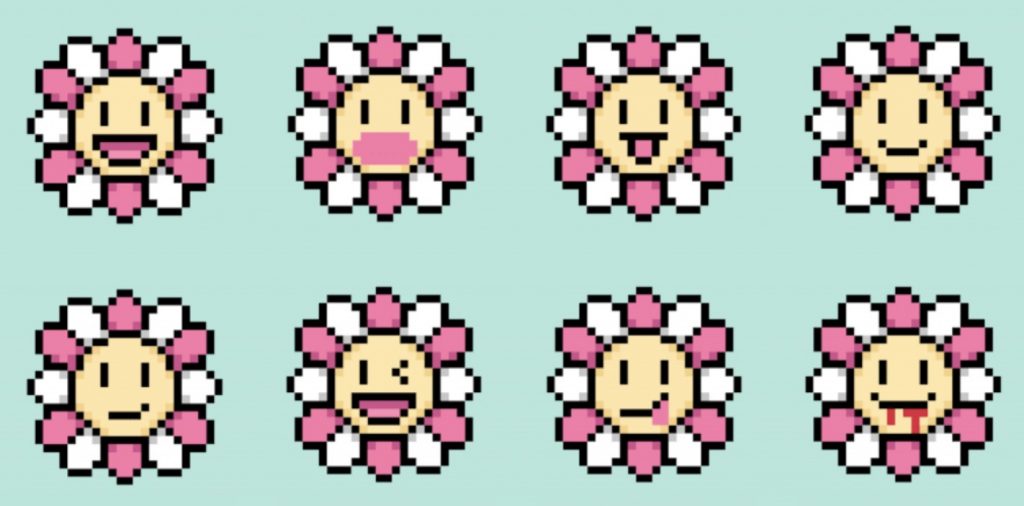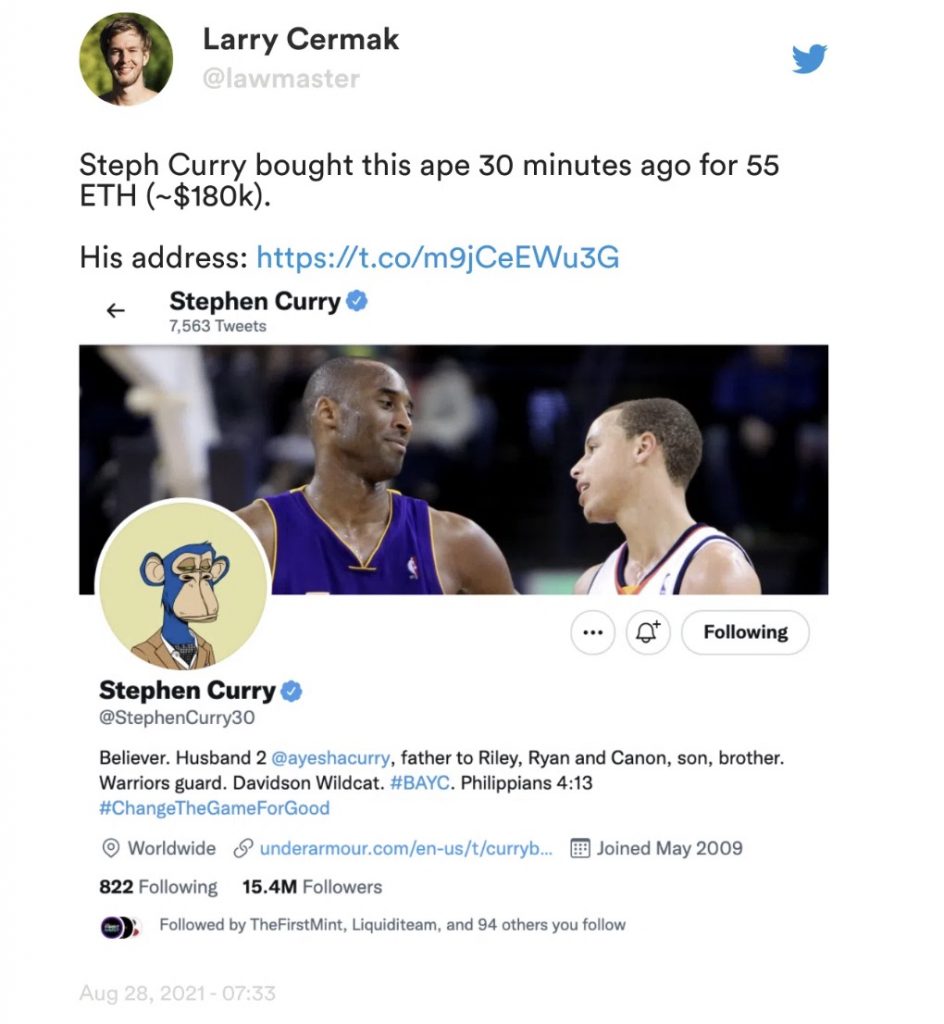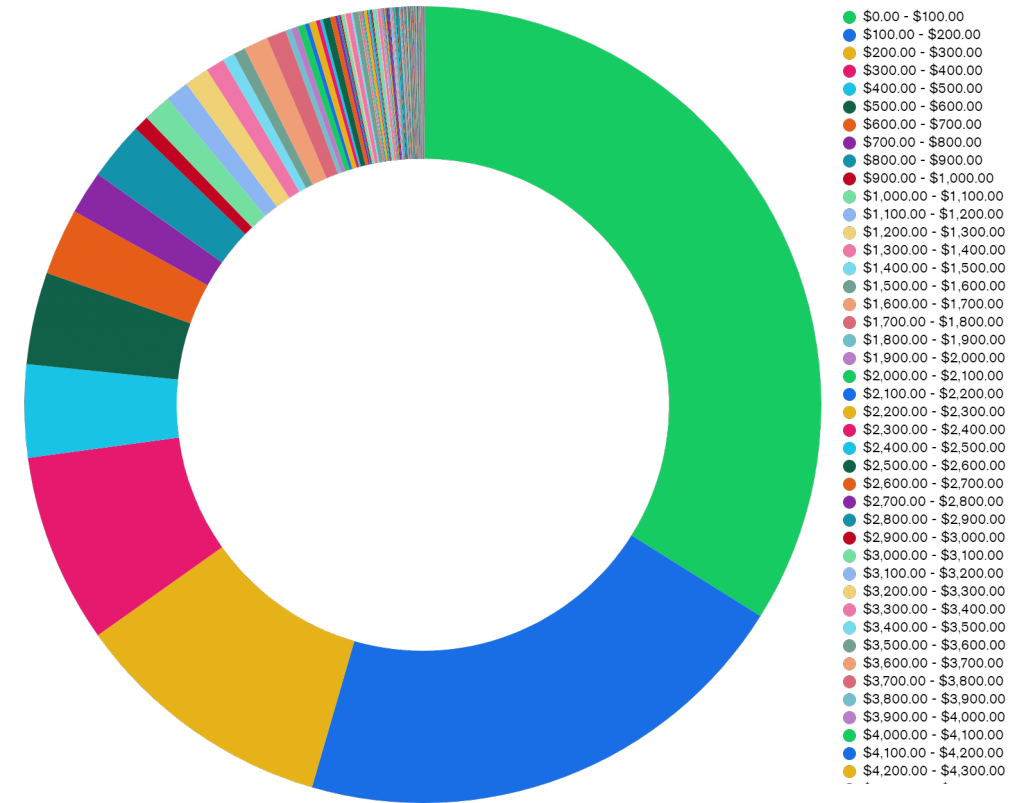NFTs, with the full name of non-fungible tokens, are popular these days around the globe. Unlike Bitcoin, NFTs are unique digital assets and each has a digital signature that allows NFTs to be “exchanged for or equal to one another”.

The most expensive NFT until now is Everydays: The First 5000 Days by Beeple, originally named Mike Winkelmann, which is a collage of the past digital artworks he created every day. It was the first completely digital art that was bided by a major auction house and finally sold for $69 million in 2021. This sale made him the third most-valued artist after David Hockney and Jeff Koons, regarding auction prices.
Although first appeared around 2014, the growth of the market for NFTs has been extremely rapid in recent years. In 2021, the whole NFT market was worth $41 billion in total, which is almost close to the total value of the entire global fine art market.
Therefore, as the NFT market booming and generating sales, many more artists are trying to take a step into it. But does every artist really need to be a part of the NFT world and does it really looks like the sweet sugar coat we see from the outside?
What makes an NFT art expensive?
Before we step into the situation and make the decisions, we should first understand the reason behind the phenomenon of NFTs’ prosperities. An article published on Beincrypto by Lulia Vasile pointed out 5 different aspects that make an NFT expensive:
- The reputation of the artist
- The community behind the NFT
- The status symbol that the NFT brings along
- Pop culture
- Technology used
The reputation of the artist:
It’s understandable for people to pursue art from famous artists as it was always like this in the history of the art market for collection and investment purposes. The reason Beeple’s work was selected by Christie’s and sold at this high value is also that he was already well-known with around 2.5 million followers in total on different social media platforms. It’s a lot easier for those artists who are already famous in the field, whether traditional artists or digital artists, to get attention on top of all other works in the sea among collectors if they want to sell their works as NFTs.
A few months ago, Takashi Murakami, the famous Japanese contemporary artist whose physical artworks have been sold worldwide for millions of dollars, announced that he will release a series of 108 NFT works on OpenSea based on his signature sunflower icon. There are already a total of 22.9K ETH amount of trade value within a month of the release. Some people even used bots to reserve the public slots because the artworks are so desirable in the market.

The community behind the NFT:
The NFT communities are often built around owners of NFTs from a specific collection. The more the number of people in the community, the more popular the NFT collection is. Cryptopunks, which are 10,000 unique collectible digital pop-art characters generated randomly by algorithm, is an example of becoming widely-spread thanks to its community members.
The status symbol that the NFT brings along:
As more celebrities come to the NFTs market, some NFTs are becoming symbols of status and popular trends. Thus, out of the mindset of chasing trends, more people would tend to buy those NFTs that have been purchased by celebrities, which makes those NFTs more similar to luxury goods from a psychological perspective.

Pop culture:
The fact that NFTs are embracing Pop art and becoming a kind of pop culture is inevitable. Sharing the common characteristics of Pop art including recognizable imagery, vibrant colors, innovative, and straight-forward, those NFTs that have iconic images and special characteristics are widely known by the public and thus the prices float to a higher level.
Technologies used:
Most NFTs rely on Ethereum blockchains for creations, data storage, and transactions. According to AZ Bigmedia, the components of NFT token metadata can include the artist or creator of the item, the description of the item, the price, the NFT creation date, the ownership of the item, specifications such as royalties, the transaction history of the asset, the new owner, and the location links of the file. There is also a “gas fee” for each transaction because Ethereum transactions need computational energy to perform. The gas fee varies for each sale based on the size of the digital work and the difficulty level of making the transaction. The estimated costs of NFT transactions based on average gas prices are listed below by NFT’s Street:
- Minting cost: $40-$100 ($70 average) to produce a single ERC721 NFT
- Listing cost: $10-$20 ($15 average)
- Auction cost: $40-$100 ($70 average)
- Destroying an NFT: $4-$10 ($7 average)
Advantages for artists to embrace NFTs
Admittedly, there are lots of advantages for artists to enter the NFT market and here are some of the most impactful ones.
- Branding: NFTs allow artists to preserve the digital footprints of their works and develop online images of themselves, which can be a good way for artists to enhance their names’ publicity and engage more audiences on the internet, especially on social media platforms.
- Traceability: It’s easier for artists to see where their artworks go and trace the art’s circulations by themselves in regards to NFTs. An NFT certificate has a unique blockchain-based identifier, which allows all the past transaction records about it to be retrieved directly from the ledger of the relevant tokenized asset.
- Resale value and sell-on fees: Based on the transparency and traceability of NFTs, artists can easily get a timely estimate of how much their works are worth in the market. Moreover, artists are supposed to get sell-on fees each time their arts are sold.
- Reach more audiences: NFTs give artists an opportunity to reach broader audiences around the world compared to physical artworks. It’s easier for their works to be seen by collectors and then sold online. Just like a black artist Niall Ashley said, “For marginalized groups, this can help further representation on a global scale.” In the video below, a Nigerian artist Abdulrahman Yusuf creating NFT artworks talked about how NFTs have changed both the art market in Africa and his life. An annual international art fair in Africa also collaborated with the digital marketplace to sell NFTs, which helped open the artists’ options and generate more opportunities to sell their works.
Bursting the dreamy bubbles surrounding NFTs
Although many have been saying that NFTs are empowering artists, especially those independent or emerging artists, to have more choices and make more money from the sales, some other statistics about the market might tell you a different story.
Often seeing the average sale prices on NFT transaction platforms and data collection websites such as Nonfungible.com, artist Kimberly Parker was skeptical about the extremely high value, and did an in-depth research on the medium price of NFT sales to find out if the averages are actually skewed and used to mistakenly represent the whole industry.
According to OpenSea, in 2021, the “average” price of an NFT sold on SuperRare is $5,800; the “average” price on MakersPlace is $2,400; and the “average” on Foundation is $3,500. However, these numbers might be skewed by large sales from those famous artists. Therefore, using the median number might be a more appropriate reference for artists who want to try NFTs.

From the graph above, we can see that most primary sales (the first sale of an NFT) prices fall into the range of $0 to $100, and more than 50% of all recorded sales were under $200. Thus, making money through NFTs is not that easy for most artists.
Another controversial issue surrounding NFTs is the artists’ rights and authorities.
NFTs were supposed to be invented to protect artists’ original works and give artists more control over their works, but it seems to go in the opposite direction. Most NFT platforms are using the same shortcut, so what people have bought is actually a link to the digital artwork, and it’s hard to tell if it’s still the original artwork many years later because the actual digital artwork couldn’t be storaged in a blockchain. According to Anil Dash, the CEO of Glitch, due to technical limits, records in most blockchains are too small to hold an entire image. Moreover, people are creating NFTs based on other artists’ works without their permission, which also hurts those artists’ rights.
In addition, there are still problems with data securities of NFT technologies and the Certificates of Authority in the digital world.
On April 4, 2021, a hacker hacked Beeple’s crypto wallet and minted a fake copy of his most expensive piece Everydays: The First 5,000 Days, the same one sold by Christie’s, on two different NFT marketplaces. Some NFT investors have also experienced the situation where their purchases simply disappeared, and there was no solution to recover the initial investment or the digital asset. Therefore, Daniel Cheung recommends having physical documentation for NFT sales until the technology is mature enough to protect the authorities and data.
Conclusion
Just like each new technology, NFT has its own advantages and disadvantages for people who use it, especially for artists and creators. For artists who want to join the NFT world, they must understand the mechanisms behind it and weigh their pays and returns before putting efforts into creating NFTs. And hopefully, there will be more regulations and the market could be more mature in the future, which might then actually help artists and the art world.
Bibliography
Clark, Mitchell. “NFTs, explained.” The Verge. August 18, 2021. https://www.theverge.com/22310188/nft-explainer-what-is-blockchain-crypto-art-faq.
Conti, Robyn & Schmidt, John. “What Is An NFT? Non-Fungible Tokens Explained.” Forbes. April 8, 2022. https://www.forbes.com/advisor/investing/cryptocurrency/nft-non-fungible-token/.
Dash, Anil. “NFTs Weren’t Supposed to End Like This.” The Atlantic. April 2, 2021. https://www.theatlantic.com/ideas/archive/2021/04/nfts-werent-supposed-end-like/618488/.
Ellis, James. “Takashi Murakami Flower NFT collection: Everything We Know So Far.” NFT Evening. February 22, 2022. https://nftevening.com/takashi-murakami-flower-nft-everything-we-know-so-far/.
“How Much Does It Cost To Sell NFT Art?” NFT’s Street. May 31, 2021. https://www.nftsstreet.com/how-much-does-it-cost-to-sell-nft-art/#:~:text=The%20site%20takes%20a%2015,passive%20future%20income%20for%20artists.
Kastrenakes, Jacob. “Beeple Sold an NFT for $69 Million.” The Verge. March 11, 2021. https://www.theverge.com/2021/3/11/22325054/beeple-christies-nft-sale-cost-everydays-69-million.
Kinsella, Eileen. “Think Everyone is Getting Rich Off NFTs? Most Sales are Actually $200 or Less, according to One Report.” Artnet. April 29, 2021. https://news.artnet.com/market/think-artists-are-getting-rich-off-nfts-think-again-1962752.
Madigan, Peter. “How NFTs Are Helping Artists To Thrive.” LinkedIn. February 22, 2022. https://www.linkedin.com/pulse/how-nfts-helping-artists-thrive-peter-madigan/.
Moore, Tash. “A Roundtable with Emerging Artists Working with NFTs.” Contemporary And. June 9, 2021. https://contemporaryand.com/magazines/a-roundtable-with-emerging-artists-working-with-nfts/.
Parker, Kimberly. “Most Artists are Not Making Money off NFTs and Here are Some Graphs to Prove It.” Medium. April 19, 2021. https://thatkimparker.medium.com/most-artists-are-not-making-money-off-nfts-and-here-are-some-graphs-to-prove-it-c65718d4a1b8.
Reuters. “’Life Changing’: African Artists Embrace NFTs.” YouTube. November 8, 2021. Video, 2:08. https://youtu.be/Lm-KV7Xwnoc.
Sayej, Nadja. “What’s an NFT? Here’s Everything You Need to Know.” Architectural Digest. March 17, 2021. https://www.architecturaldigest.com/story/nft-everything-you-need-to-know.
Taylor, Emily. “How NFT Minting Works – An Initial Guide to NFTs.” Azbigmedia. October 29, 2021. https://azbigmedia.com/business/how-nft-minting-works-an-initial-guide-to-nfts/.
“Top NFTs.” OpenSea. Accessed May 6, 2022. https://opensea.io/rankings.
Vasile, Lulia. “NFT Art: How is It Different From Traditional Art.” Beincrypto. December 23, 2021. https://beincrypto.com/learn/nft-art-vs-traditional-art/.
“What is Pop Art? Techniques, artists, and Examples that Shaped the Movement.” Invaluable. Accessed May 6, 2022. https://www.invaluable.com/blog/what-is-pop-art/.
“Why Traditional Artists should Ignore the NFT Hype (For Now).” Artwork Archive. Accessed April 22, 2022. https://www.artworkarchive.com/blog/why-traditional-artists-should-ignore-the-nft-hypefor-now.